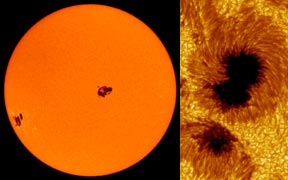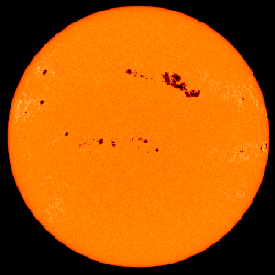The Sun on March 30, 2001. You can see the huge sunspot in the upper, right hand part of the Sun. Though it doesn't look like much, this area is equivalent to the surface area of 14 Earths! The sunspot has since moved so that it is on the far side of the Sun from Earth.
Click on image for full size
Courtesy of Spaceweather.com
Massive Sunspot! (Updated!)
News story originally written on April 4, 2001
The largest
sunspot of the decade has shown its face on
the Sun.
Another flare has shot from this sunspot! It was released at 4:51 EDT, Monday.
Because the Sun rotates, this massive sunspot moved across the Sun in the last week to the far side of the Sun as viewed from Earth. That means the flare's resulting coronal mass ejection (CME) won't hit the Earth directly. But this flare is so huge (an X-20 classification), that it will affect the Earth. This means there may be increased auroral activity which could possibly be viewed the nights of April 4th and 5th.
Dr. Paal Brekke, the European Space Agency Deputy Project
Scientist for the Solar and Heliospheric Observatory (SOHO), one of a fleet of spacecraft monitoring solar activity and its
effects on the Earth, said this flare, "was more powerful that the famous
March 6, 1989 flare which was related to the disruption of the
power grids in Canada." So, if the sunspot hadn't moved across the Sun in the last week, this solar event could have struck Earth with its full force. Then there could've been serious radio disruptions or power blackouts!
Stay tuned to Spaceweather.com for updates!
You might also be interested in:

Sunspots are dark, planet-sized regions that appear on the "surface" of the Sun. Sunspots are "dark" because they are cooler than their surroundings. A large sunspot might have a central temperature of
...more
It was another exciting and frustrating year for the space science program. It seemed that every step forward led to one backwards. Either way, NASA led the way to a great century of discovery. Unfortunately,
...more
The Space Shuttle Discovery lifted off from Kennedy Space Center at 2:19 p.m. EST, October 29th. The sky was clear and the weather was great as Discovery took 8 1/2 minutes to reach orbit for the Unitied
...more
A moon was discovered orbiting the asteroid, Eugenia. This is only the second time in history that a satellite has been seen circling an asteroid. A special mirror allowed scientists to find the moon
...more
Will Russia ever put the service module for the International Space Station in space? NASA officials are demanding an answer from the Russian government. The necessary service module is currently waiting
...more
During a period of about two days in early May, 1998, the ACE spacecraft was immersed in plasma associated with a coronal mass ejection (CME). The SWICS instrument on ACE, which determines unambiguously
...more
J.S. Maini of the Canadian Forest Service has referred to forests as the "heart and lungs of the world." Forests reduce soil erosion, maintain water quality, contribute to atmospheric humidity and cloud
...more















